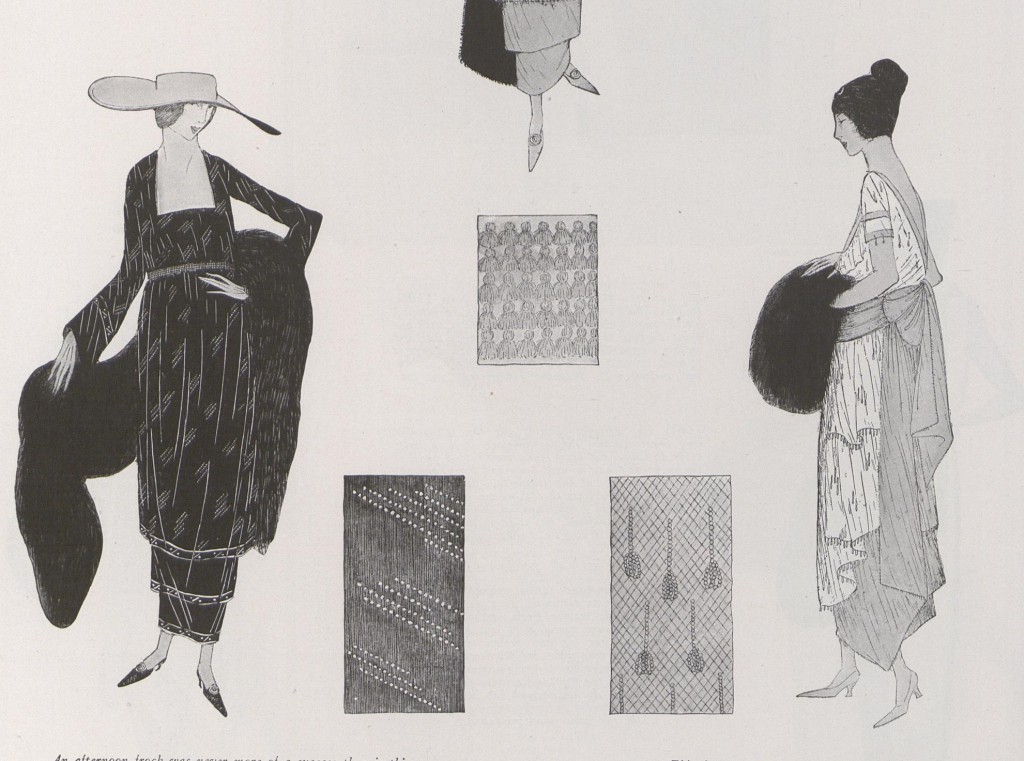The December 1918 issues of Vogue carried an unsettling mixture of features. Several articles prepared before the Armistice reported on the lasting effects of the war effort on the bodies of both civilian war workers and servicemen. A piece promoting American YWCA – run hostels and rest centres for young women in France discussed the munitions factories staffed by women working sixteen-hour days in toxic and often lethal conditions:
Lucienne also died for France. She was just nineteen – so young to die. But when one is a refugee from the invaded country, one doesn’t care much about death. A shell slips from one’s fingers – one’s dress catches fire – pouf! It is all over but the hospital for an hour or so, and then the priest in his black robes, chanting. One is lucky to have a funeral.
In England, the YWCA had opened a hostel for the 600 young women per fortnight who were sent to join the Women’s Auxiliary Army Corps in the front line. The scale of women’s involvement in the war effort was unprecedented, and the damage to their health, though never officially reckoned, must have been enormous. A more visible outcome of the war was the large number of veterans who were returning with permanent injuries. Another article draws a stark contrast between the youthful vigour of army recruits playing football in Manhattan and those disembarking from a hospital ship on Ellis Island, which was received 800 injured veterans each week, with a total of over 50,000 so far. The article discusses the treatment of these men in specialist hospitals, including one for ‘mental cases’, an early acknowledgement of the prevalence of what we now call PTSD. It also warns that the recovery process can take years, and requires not only physical retraining but also mental adjustment to new bodily limitations – and, crucially, understanding employers. The difficulty of finding employment is obliquely implied by the establishment of workshops where toys and other products were made by injured veterans.
Perhaps surprisingly, the fashion features this month also have an air of disillusionment. The review of the latest trends in bridal wear notes that the smart set are finally leaving their wartime boltholes in Biarritz and Monaco to return to Paris, and that restaurant dinners and social events are resuming: but with additional charges imposed on American clients which made eating out unaffordable.
There are also several articles that discuss wartime changes in attitudes to beauty, and the new trends in hairstyles and makeup. The fashion for short or ‘bobbed’ hair is covered through a fictive debate, with the journalist relating it to the air raids and shortages of hot water that made hair care difficult. Her fictive interlocutor disagrees, saying that bobbed hair is a matter of fashion, with women copying each other in an attempt to look different but ending up all looking the same. This leads to an interesting reflection on the tension between conformity and individualism in fashion:
There is nothing so exhausting as people who are ‘different’; both the woman who scorns fashion, and the original thinker who always opposes the majority. She claims that if people were all entirely different from one another, we should have to give far too much attention to each of them, that we should have to make a great deal of every trifle.
Where both sides of the debate agree is in the unflattering nature of the new short haircut, particularly for older women, as it makes them look as if they are trying to imitate their daughters, and restricts the face-framing possibilities of longer hair. Vogue is also surprisingly negative about the new fashion for obvious make-up,warning that ‘Very charming was the effect as the lady dashed by in her car, but, oh, what a disillusion at close range!’ A lengthy article is devoted to advice on skin care products and application, including the need to choose an appropriate shade. Different ranges are described and sketched in detail, but the writer is strangely coy about mentioning the brand names – perhaps because they had not paid for advertising. However it is likely that the ‘Russian whose reputation circles the world’ is a reference to the Polish-born Helena Rubinstein, who had set up a New York salon in 1915 after establishing herself in Australia, London and Paris. For readers who could not afford exclusive skin care treatments, the writer stresses the importance of rest, healthy food and exercise – and refers to the effects of weight loss on the skin.
There is also a brief feature on the garments prepared for the stage star Florence Walton by the House of Premet. This is refreshingly honest about the rationale behind the innovative embroidery that was such a feature of 1918 fashions: ‘To overcome the lack of figured materials, Paris embroiders,tassels or beads a plain fabric’. This gives close-up sketches that demonstrate how the decorative effects have been worked. They include the use of fluffy wool tassels to imitate bands of fur, making a virtue of the lack of luxury materials. The article is frank about this rationale:
The making of these elaborate all-over embroidered materials has a double purpose: to produce variety in the midst of a monotony of plain materials (all that the looms have been able to turn out this season), and to give work to hundreds of otherwise idle little sewing girls.
Thus the links between war, economics, and fashion, too often elided in histories, is addressed directly in one of the main organs of the fashion trade.



